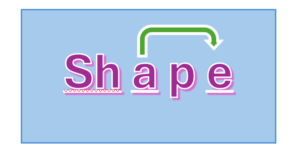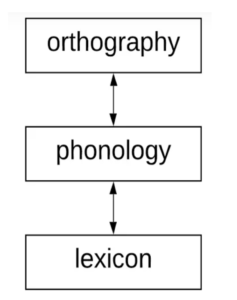Sight Word Lexicons – Every word wants to be a sight word when it grows up!
A sight word is a word that can be effortlessly and instantaneously read when seen. This gives the impression that the reader does not decode the word and is why it was previously thought that words could be taught via the visual route.
A sight word vocabulary is not based on visual memory or visual skills. Input and storage are not the same thing. Input is visual, storage is orthographic via phonological proficiency. Whilst visual shape memory is critical for ‘letter name’ learning, it plays little role in ‘word reading’ because letters are an abstract representations in memory (Kilpatrick 2019).
All words, including a small amount of irregular high frequency words need to be explicitly taught and practiced through repeated decoding and careful explanation of the grapheme phoneme connections.
Sight words are not taught as whole words. Rather, they are taught through the phonological and orthographic pathway and are stored in the sight word lexicon via the mental process of orthographic mapping (Ehri ).
For example:
If a child is learning the sounds s,a,t,p,i,n, they may also need to learn ‘a’, ‘the’, ‘she’ and ‘has’, in order to read a grammatically correct sentence.
Should words be taught by Sight?


The simple answer is ‘No’…. Words are not recognised by configuration (shape). Words recognition depends on fast, accurate, phoneme- grapheme mapping! Context does not drive word recognition or printed word memory (Moats 2018).
Children must learn that there is only one approach required to read unfamiliar words. That is to decode. When children are taught differently, such as trying to remember words as a whole unit, it can be very confusing and result in establish poor reading habits.
When children are learning to read using a systematic, synthetic approach they will come across words that have a far more advanced code than what they have already learnt. Decodable texts introduce, ‘high frequency words’, or ‘tricky words’, which need to need to explicitly be decoded and explained to the students.
So How Should High Frequency Words be taught!
‘High frequency’ words or ‘Tricky Words’ need to be mapped via the phonological and orthographic pathway. To assist students, build their sight word lexicon (orthographic) by providing frequent mapping opportunities.
Example 1: How to teach the word ‘do’
- Tell the child the word.
- Explain that the ‘o’ in some words can be heard as /oo/.
- Sound out (decode) the individual phonemes for the child to hear d/o.
- Expose students to other words that are similar, like the word ‘to’.
Mapping Exercises & How to Teach High Frequency Words
Help students map the phonemes and graphemes in regular words and opaque words. Include targeted practice mapping of common high frequency words alongside phonics instruction. (Kilpatrick 2019)
Phoneme-grapheme mapping is a way to explicitly illustrate the relationship between phonemes (sounds) and their graphemes (letters). It allows students to connect or match the graphemes with the sounds they represent. The above diagram shows the bidirectional process which helps bond spellings to pronunciations in memory.
High-Frequency Words:
High Frequency Words are those words that are most commonly used in print. These words can be divided into two categories: those that are phonetically decodable and those with irregular spellings.
To help students map the phonemes and graphemes in regular words and opaque words. Include targeted practice mapping of common high frequency words alongside phonics instruction (Kilpatrick 2019).

Basic Structure of Mapping Lesson (This can be used for regular and opaque words).
- Say the word. Have students say the word.
- Define the word.
- Repeat the word.
- Pull apart the word into its individual phonemes.
- Use manipulatives, ‘Elkonin boxes’, or draw dots to map each sound.
- Align the phonemes to the printed letters.
- Point out specific phonetic and orthographic features of the word.
Flash Words & Heart Words (refer to attached link for further information)
These are terms used for instructional purposes by Louisa Moats and Carol Tolman (2019), to describe words with are either phonically regular (decodable) or irregular (words that contain irregular spellings).
Flash Words: refer to high-frequency words that are regularly spelled and thus decodable as or words that can be “read or spelled in a flash” for example, can, not, did.
Heart Words: refer to irregularly spelled words, whereby some part of the word will have to be “learned by heart.” Heart Words are also used frequently in texts and will need to be read and spelled automatically for example, said, are, was & where.
Links to further learning and resources
A New Model for Teaching High-Frequency Words | Reading Rockets
How we develop orthographic mapping – Five from Five
A New Model for Teaching High-Frequency Words | Reading Rockets (2025)
Five from Five Teaching grapheme-phoneme correspondences – Five from Five

